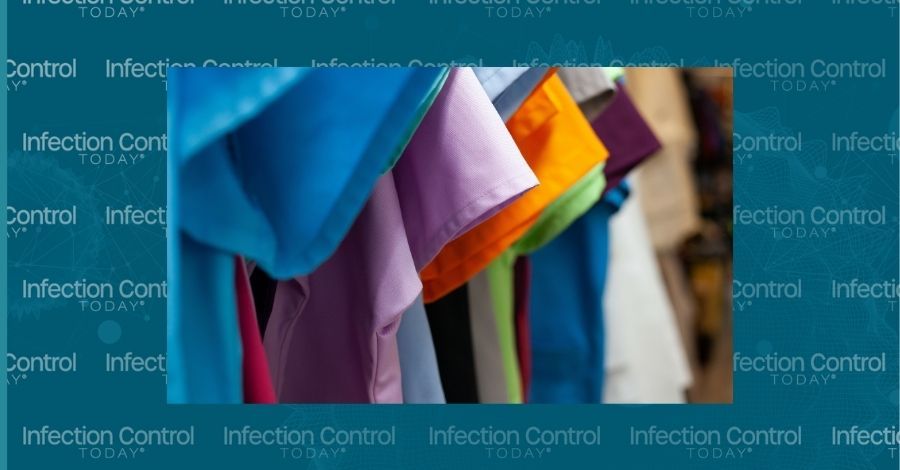Optimal Laundering of Reusable Surgical Scrubs: A Comprehensive Review
Read a literature review that examines methods for laundering reusable surgical scrubs. Discover the importance of water temperature, disinfectants, and more in infection control.
Hanging scrubs in many colors (Adobe Stock by Jesse 344038847)

Preventing health care-associated infections is a top priority for infection prevention personnel. Often overlooked in infection control is the possibility of harmful pathogens being transmitted through contaminated surgical scrubs worn by surgical personnel. These dedicated professionals are crucial in saving lives, but their clothing can unintentionally become carriers of microbes, endangering both patients and themselves.
Surgical personnel, including surgeons, nurses, and support staff, are on the frontlines of patient care, and their scrubs are exposed to a wide array of potential contaminants during surgeries and other medical procedures. Contaminated scrubs can serve as vectors for the transmission of infectious diseases, putting patients, hospital environments, and even the personnel's homes at risk.
To address this critical issue, a systematic literature review was conducted to identify the optimal methods for laundering reusable surgical scrubs by Je’nine Horn-Lodewyk and colleagues from the Department of Clinical Sciences, Faculty of Health and Environmental Sciences, Central University of Technology in Bloemfontein, South Africa.
“A limited amount of literature on healthcare professionals’ knowledge, education, and training on optimal laundering methods could be located,” the investigators wrote. “Furthermore, a lack of knowledge among theatre staff on home laundering of their scrubs has been reported. Health care professionals working in an active theatre environment lack information about infection management in the theatre environment.”
This comprehensive analysis sought to provide health care professionals and hospital management with clear guidelines for effective scrub decontamination. The research established a direct correlation between water temperature and washing cycle length. Higher water temperatures were found to necessitate shorter washing cycles. After laundering in low or medium water temperatures, tumble drying and ironing should follow. Importantly, regardless of water temperature, the inclusion of a disinfectant in the washing process is crucial to ensure effective decontamination.
Horn-Lodewyk and colleagues found that there is no consensus among article authors on the most effective method for laundering surgical scrubs. Some articles provide only vague information about the required water temperature without specifying the exact degrees, disinfectants, and duration needed. This incomplete information does not help to fill the knowledge gap about how personnel can optimally launder their contaminated scrubs at home without contaminating the environment.
“The Association of Surgical Technologists (AST) proposed a set of guidelines compiled from the literature for best practices for laundering surgical scrubs,” Horn-Lodewyk and colleagues wrote in the review. “In the guidelines, the AST emphasizes that health care delivery organizations must develop and approve policies and protocols for laundering scrubs. The AST guidelines do not recommend home laundering as it cannot be properly monitored. Should [surgical] theatre personnel be required to perform home laundering, the employer should provide them with information on infection control and laundering guidelines. The AST guidelines also provide information on the handling, storing, and transporting of [surgical] scrubs to prevent contamination with microorganisms."
The investigators continue, “Hence, hospitals have set decontamination laundering protocols related to the infection control of scrubs worn by [surgical] personnel. These protocols should focus on scrubs being laundered at the hospital or at a hospital-approved facility and the manner in which the soiled scrubs are transported to and from the washing facility. Some hospitals allow staff to launder their scrubs at home, even though washing practices may vary.”
The results obtained from this research underscore the importance of adhering to optimal laundering guidelines for both hospital and home laundering processes. Factors such as water temperature, washing time, mechanical action, disinfectant type, and heat all play a pivotal role in successfully removing bacteria and pathogens from surgical scrubs.
Newsletter
Stay prepared and protected with Infection Control Today's newsletter, delivering essential updates, best practices, and expert insights for infection preventionists.
Reducing Hidden Risks: Why Sharps Injuries Still Go Unreported
July 18th 2025Despite being a well-known occupational hazard, sharps injuries continue to occur in health care facilities and are often underreported, underestimated, and inadequately addressed. A recent interview with sharps safety advocate Amanda Heitman, BSN, RN, CNOR, a perioperative educational consultant, reveals why change is overdue and what new tools and guidance can help.
New Study Explores Oral Vancomycin to Prevent C difficile Recurrence, But Questions Remain
July 17th 2025A new clinical trial explores the use of low-dose oral vancomycin to prevent Clostridioides difficile recurrence in high-risk patients taking antibiotics. While the data suggest a possible benefit, the findings stop short of statistical significance and raise red flags about vancomycin-resistant Enterococcus (VRE), underscoring the delicate balance between prevention and antimicrobial stewardship.
What Lies Beneath: Why Borescopes Are Essential for Verifying Surgical Instrument Cleanliness
July 16th 2025Despite their smooth, polished exteriors, surgical instruments often harbor dangerous contaminants deep inside their lumens. At the HSPA25 and APIC25 conferences, Cori L. Ofstead, MSPH, and her colleagues revealed why borescopes are an indispensable tool for sterile processing teams, offering the only reliable way to verify internal cleanliness and improve sterile processing effectiveness to prevent patient harm.
The Next Frontier in Infection Control: AI-Driven Operating Rooms
Published: July 15th 2025 | Updated: July 15th 2025Discover how AI-powered sensors, smart surveillance, and advanced analytics are revolutionizing infection prevention in the OR. Herman DeBoard, PhD, discusses how these technologies safeguard sterile fields, reduce SSIs, and help hospitals balance operational efficiency with patient safety.
Targeting Uncertainty: Why Pregnancy May Be the Best Time to Build Vaccine Confidence
July 15th 2025New national survey data reveal high uncertainty among pregnant individuals—especially first-time parents—about vaccinating their future children, underscoring the value of proactive engagement to strengthen infection prevention.